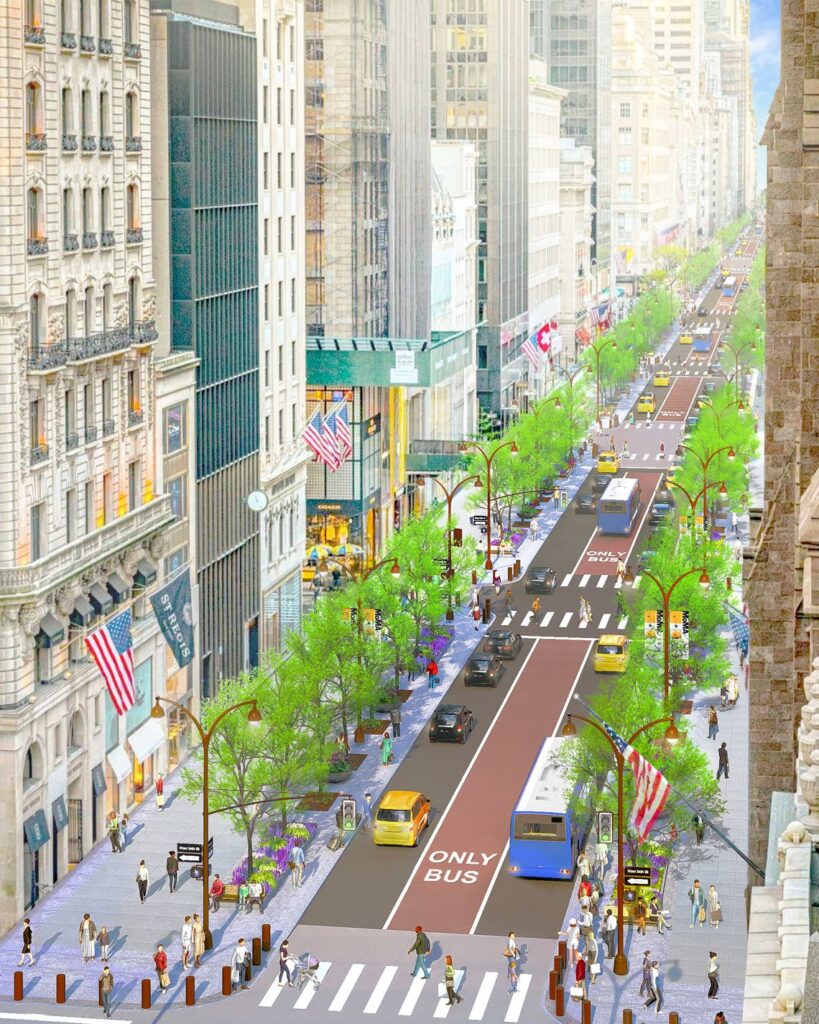New York City’s Fifth Avenue has long been a symbol of luxury, culture, and urban vibrancy. Home to world-renowned stores, cultural institutions like the Metropolitan Museum of Art, and historic landmarks, it stands as one of the most iconic streets in the world. Yet, as we progress into the 21st century, this famous avenue is undergoing a radical transformation aimed at creating a more pedestrian-friendly, environmentally conscious space. The ambitious plan focuses on introducing more trees, expanding sidewalks, and reducing car traffic—a design aimed at making Fifth Avenue greener, walkable, and ultimately, more sustainable.
Interestingly, this move towards urban renewal mirrors efforts seen nearly a century ago in the 1930s, when New York City first began rethinking its streets to accommodate the needs of a growing metropolis. Then, as now, the city sought to find a balance between transportation and creating spaces that fostered community, culture, and a healthier environment. By examining both eras, we can see how the city’s approach to urban planning is both a response to modern challenges and a reflection of its historical legacy of adaptation.
A Vision of the Future for Fifth Avenue
The current initiative to revamp Fifth Avenue is part of New York City’s larger effort to make the city more livable and environmentally friendly. This new vision is driven by several factors, including the increasing demand for pedestrian space, the need to combat climate change, and the desire to reduce car congestion in favor of more sustainable modes of transport.
The plan for Fifth Avenue includes the expansion of sidewalks to accommodate more foot traffic and provide space for greenery. More trees will line the avenue, offering shade in the summer and a much-needed breath of fresh air in the dense urban environment. These trees will not only beautify the streetscape but also play a key role in reducing urban heat and improving air quality. The wider sidewalks will also encourage more pedestrian activity, transforming Fifth Avenue into a more inviting space for both locals and tourists.
Additionally, the initiative calls for a significant reduction in car traffic. With fewer cars, the avenue will become a safer and quieter place, allowing for a more leisurely and enjoyable experience. The reduction in vehicles also aligns with the city’s broader sustainability goals, as fewer cars mean lower emissions, helping New York City in its fight against climate change.
This reimagined Fifth Avenue will emphasize human interaction and community, with public seating, outdoor dining, and pedestrian plazas. The aim is to create a space that is more than just a thoroughfare for vehicles and shoppers, but a vibrant urban space that fosters socialization and relaxation.
Looking Back: The Urban Planning of the 1930s
The transformation of Fifth Avenue in the 21st century is reminiscent of the urban planning trends that emerged in the 1930s. During this period, New York City faced challenges similar to those of today: rising populations, increased traffic congestion, and the need for better public infrastructure. In response, city planners embarked on a series of initiatives designed to modernize the city while also preserving its character.
One of the most significant projects of the 1930s was the redesign of Broadway, New York’s other iconic avenue. As cars became more common, Broadway struggled to accommodate the increasing volume of traffic. At the same time, there was a growing recognition of the importance of pedestrian spaces. The city responded by widening sidewalks, improving lighting, and adding tree-lined streets. These changes were intended to make Broadway more inviting for pedestrians while still allowing for vehicular traffic.
Similarly, the 1930s saw the development of new public spaces, including parks and pedestrian plazas. These projects were part of a broader movement towards creating a healthier and more livable city, one that balanced the needs of its residents with the demands of a modern metropolis. The expansion of the subway system during this time also played a key role in reducing the need for cars, just as today’s emphasis on public transportation and cycling aims to reduce traffic on Fifth Avenue.
The 1930s were a period of innovation in urban planning, with projects that sought to make New York City both a symbol of modernity and a place that promoted community and well-being. The current transformation of Fifth Avenue reflects many of these same goals, with a renewed focus on creating spaces that are designed for people, not just vehicles.
The redesign of Fifth Avenue is more than just an aesthetic upgrade; it represents a shift in how urban spaces are used and experienced. By prioritizing pedestrians over cars, the city is embracing a model of urban living that is healthier, more sustainable, and more connected.
One of the most immediate benefits of this transformation is the improvement of air quality. Trees are natural air filters, absorbing carbon dioxide and releasing oxygen, while also helping to reduce the heat island effect that makes cities like New York hotter than surrounding areas. The increased greenery will create a more pleasant environment for pedestrians, making the avenue cooler in the summer and more visually appealing year-round.
Moreover, the wider sidewalks and pedestrian plazas will encourage more walking and outdoor activities. In a city where space is at a premium, creating areas where people can gather, relax, and socialize is vital for fostering a sense of community. The new Fifth Avenue will provide opportunities for outdoor dining, street performances, and other activities that make the city’s public spaces vibrant and engaging.
Reducing car traffic will also have a profound impact on the overall atmosphere of the avenue. With fewer vehicles, the noise level will drop, and the risk of accidents will decrease, making Fifth Avenue a safer and more enjoyable place to visit. This shift away from car dependency is part of a broader trend in urban planning, where cities around the world are rethinking their streets to prioritize pedestrians, cyclists, and public transport.
Impression
The transformation of Fifth Avenue is a reminder that cities are constantly evolving in response to the needs of their inhabitants. Just as New York City in the 1930s adapted to the rise of automobiles and the changing demands of a modern metropolis, today’s city is responding to the challenges of climate change, sustainability, and the desire for more livable spaces.
The similarities between the two eras of urban planning highlight the cyclical nature of city development. In both cases, the goal was to create a healthier, more vibrant urban environment. In the 1930s, this meant widening sidewalks and adding trees to make the streets more inviting for pedestrians. Today, the same strategies are being used to reduce car traffic and create greener, more walkable spaces.
As Fifth Avenue undergoes this transformation, it serves as a symbol of New York City’s resilience and adaptability. The new Fifth Avenue will not only reflect the city’s past but also point the way towards a more sustainable and inclusive future. Through thoughtful urban planning, the city is creating spaces that prioritize people, community, and the environment—an approach that echoes the forward-thinking strategies of the 1930s while addressing the challenges of the 21st century.
As New York City reimagines Fifth Avenue, it does so with the lessons of the past in mind. The transformation of this iconic street into a greener, more pedestrian-friendly space reflects the city’s commitment to sustainability and community, just as urban planners in the 1930s sought to make New York more livable through innovative designs and infrastructure. With wider sidewalks, more trees, and fewer cars, the new Fifth Avenue will not only enhance the experience of walking along one of the world’s most famous streets but also set a precedent for future urban planning in cities around the globe.
No comments yet.







